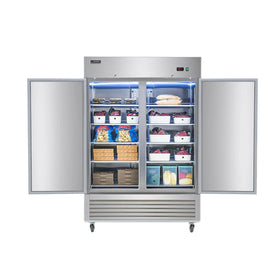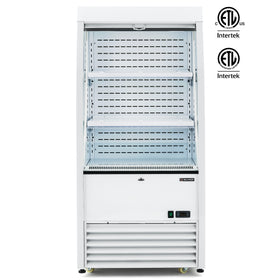A commercial freezer that is well-organized enhances overall efficiency in the sense that it keeps different food items at the right temperature, helps you reduce food waste, saves time during service, and ensures you stay compliant with food safety regulations.
But organizing a commercial freezer is not just about knowing what goes on which shelf. A commercial freezer has to be organized for efficiency, accessibility, and (depending on the model), visibility.
How do you organize a commercial freezer? What should your priority be, and how does the process change when you are organizing a single-door, double-door, or three-door model?

Start by Setting Your Priorities
Organizing a commercial freezer does not begin when you start putting the items in. Even before putting anything in, it is important to start by laying down your objectives and priorities.
Priorities for organizing a commercial freezer may differ depending on what food items you intend to organize and what kind of freezer it is; however, you want to keep the following objectives in mind when organizing any commercial freezer:
- Food safety: Raw and cooked foods must be kept separate to prevent contamination.
- Temperature consistency: The freezer should not be overcrowded; cold air needs to circulate freely.
- Efficiency. Frequently used items should be placed where your team can grab them quickly.
- Inventory management. Label and rotate stock using the FIFO (First In, First Out) method to cut down on waste.
How to Organize a Commercial Freezer (Shelf by Shelf)
When you organize your commercial freezer, your objective has to be ensuring that every shelf serves a specific purpose.
From the top shelf to the bottom shelf, the food items have to be organized in such a way that cross-contamination is prevented and food safety is maximized.
i. The Top shelves: For Ready-to-eat and cooked foods
The top shelf of a commercial freezer should be reserved for ready-to-eat foods and already-cooked foods.
Place cooked meals, baked goods, and frozen fruits or desserts here. Since they are ready to use/eat, these items should be kept furthest from potential drips or spills.
ii. Middle shelves: For prepped or packaged ingredients
In a commercial freezer, the middle shelves are for prepped or packaged ingredients. Store frozen vegetables, sauces, soups, and dairy in the middle shelves.
These are usually sealed and less risky, but should still stay clear of raw proteins. Hence, they go on the middle shelf.
iii. Bottom shelves: Raw meats, poultry, and seafood
The bottom shelf or shelves of your commercial refrigerator should be for raw meats and seafood. Always keep raw proteins on the lowest shelves to prevent contamination.
Make sure you use trays or pans to catch any juices from the meats (before they freeze), and whatever you do, never stack them on top of cooked or ready-to-eat foods.
iv. Drawers or bins: For Bulk storage or infrequent items
Store backup supplies or large-volume items like frozen stock here. These are accessed less frequently, so keeping them lower helps maintain airflow and temperature stability.

Tips For Organizing Commercial Freezers By Size: Single, Double, and 3-Door Units
Another important factor to consider when organizing a commercial freezer is how many doors it has.
For smaller single-door models, you need to focus on space optimization; meanwhile, for larger 3-door models, the focus is on accessibility and visibility.
1. Organizing a Single-door Commercial Freezer
With commercial single-door freezers, pace is limited, so the priority when organizing is visibility. Here are two important tips for organizing a single-door commercial freezer:
- Use adjustable shelves to group items by category and rotate stock frequently.
- Also, label everything clearly so staff can find what they need quickly.
2. Organizing a Double-Door Commercial Freezer
When organizing a double-door freezer, especially if it is a solid-door reach-in model, it is advisable to designate each side for a specific category of product, e.g., one for meats and seafood, the other for prepared foods and vegetables. This setup speeds up service and reduces the risk of cross-contamination.
3. Organizing a Commercial 3-Door Freezer
Commercial 3-door freezers have more space and offer the most flexibility when it comes to organizing. Follow these two important tips:
Dedicate each section to a food group (for example: door 1 for raw proteins, door 2 for ready-to-eat foods, door 3 for bulk storage or desserts).
Ensure the labelling and sectioning are consistent so staff can stay organized even during rush hours.

Organizing a Commercial Reach-In Freezer vs. Organizing a Commercial Display Freezer
| Feature / Focus | Reach-In Freezer | Display Freezer |
| Primary Use | For kitchen staff and back-of-house food storage | Customer-facing for product display and self-service |
| Organization Goal | Efficiency, hygiene, and quick access during cooking | Visibility, product appeal, and boosting sales |
| Shelf Arrangement | Raw meats at the bottom, ready-to-eat foods on top, and frequently used items at eye level | Group by category (ice cream, frozen meals, vegetables), with best-sellers at eye level |
| Product Presentation | Functional, focused on safety and workflow | Attractive and easy to browse with clear labels and dividers |
| Key Benefit | Enhances kitchen speed and safety | Improves customer experience and sales potential |
Organizing a Commercial Reach-in Freezer
Commercial reach-in freezers are designed for kitchen staff use, so when organizing, the focus should be on convenience, practicality, and food safety.
To achieve this, you group the items by their use: ready-to-eat foods up top, raw meats at the bottom, and frequently used ingredients at eye level. The goal is speed and hygiene during cooking operations.
Organizing a Commercial Display Refrigerator
A commercial display freezer, on the other hand, is customer-facing. The focus when organizing is on visibility and product appeal.
Organize by category (e.g., ice cream, frozen meals, vegetables), with best-sellers and impulse items at eye level.
For a display freezer, it is important to keep labels facing forward and use clear containers or dividers to make products easy to see and grab. The organization here boosts sales while still keeping everything cold and safe.

Why a Well-Organized Freezer Matters
A properly organized commercial freezer delivers more than just a clean look: it streamlines your operations.
You’ll reduce food waste, maintain consistent temperatures, and keep ingredients fresh longer. Staff can work faster, health inspections go smoothly, and you’ll avoid costly product spoilage.
When everything in your freezer has its place, your kitchen runs more efficiently, and that efficiency shows up on your bottom line. So, take the time to organize it right. Your team, your customers, and your profits will all thank you.
You might want to explore more about ideal commercial freezer temperatures for storing different items.










